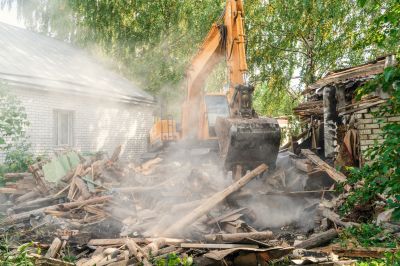Ultimate Guide to Demolition Service Equipment for Heavy Projects
Learn about the key machinery and tools that support successful demolition operations across different job sizes.
 Demolition services in Middletown, OH, require a diverse array of specialized products to ensure safe and efficient work. From handheld tools to heavy machinery, selecting the right equipment is crucial for completing demolition projects effectively. Proper tools can help mitigate risks, improve productivity, and ensure compliance with safety standards. Whether working on small interior demolitions or larger structural removals, having access to quality demolition products is essential for contractors and DIY enthusiasts alike.
Demolition services in Middletown, OH, require a diverse array of specialized products to ensure safe and efficient work. From handheld tools to heavy machinery, selecting the right equipment is crucial for completing demolition projects effectively. Proper tools can help mitigate risks, improve productivity, and ensure compliance with safety standards. Whether working on small interior demolitions or larger structural removals, having access to quality demolition products is essential for contractors and DIY enthusiasts alike.
Top Overall Option
Heavy-Duty Demolition Hammer
A versatile demolition hammer designed for breaking through tough materials such as concrete, brick, and stone. It offers powerful impact force combined with ergonomic handling to reduce user fatigue. Suitable for both professional contractors and serious DIYers, this tool can handle a variety of demolition tasks with precision and control.
Types of Products For Demolition Service
Demolition Hammers
Powerful handheld tools used for breaking concrete, masonry, and other hard surfaces.
Rotary Demolition Drills
Heavy-duty drills designed for drilling into concrete and stone, often used in conjunction with chipping attachments.
Concrete Crushers
Machines or attachments that pulverize concrete into manageable pieces for removal or recycling.
Hydraulic Breakers
Hydraulic-powered tools attached to excavators for breaking large concrete structures or rocks.
Sledgehammers
Traditional manual tools ideal for breaking smaller structures or for use in tight spaces.
Reciprocating Saws
Power saws equipped with demolition blades for cutting through wood, metal, or drywall.
Dust Extraction Systems
Equipment designed to control dust and debris during demolition work, promoting safer environments.
Safety Gear
Protective equipment including helmets, gloves, goggles, and respiratory masks essential for safe demolition practices.
Demolition Buckets
Attachments for excavators that facilitate material removal and debris handling.
Cutting Attachments
Specialized blades and saws for precise cuts in various materials.
Scaffolding and Support Structures
Equipment to safely access elevated or hard-to-reach areas during demolition.
Vacuum Systems
Industrial vacuums used to clean up debris and dust efficiently during and after demolition.
Plasma Cutters
High-temperature cutting tools suitable for precise metal demolition tasks.
Wire and Chain Slings
Lifting and securing heavy debris or structural elements safely.
Air Compressors
Power sources for pneumatic demolition tools and accessories.
Tool Storage and Transport Equipment
Durable cases, carts, and racks for organizing and moving demolition tools efficiently.
Popular Choices
Corded or cordless saws used for cutting through drywall, wood, and thin metal components.
Air-powered tools favored for their power and durability in heavy demolition tasks.
Heavy-duty chainsaws designed specifically for cutting through concrete and masonry.
Essential protective gear to prevent inhalation of dust particles during demolition.
Manual tools used for prying apart materials and removing nails or fasteners.
Attachments for excavators that cut through steel and reinforced concrete.
Protective gloves designed for enhanced grip and hand safety during demolition work.
Lighting solutions to illuminate work areas, especially in enclosed or poorly lit spaces.
Equipment to assist in lifting and stabilizing large debris or structural elements.
Tools for removing flooring materials during interior demolition projects.
Supports used to stabilize structures during partial demolition.
Systems that reduce dust during cutting and breaking activities.
Power sources for tools and lighting in remote or outdoor demolition sites.
Equipment to safely direct debris from upper levels to ground level for cleanup.
Pads that reduce noise and vibration impact during demolition work.
Adjustable platforms for safe access to elevated demolition areas.
Heavy-duty gloves that provide protection against cuts, abrasions, and impacts.
In demolition work, versatility and durability are key factors. Products must withstand rigorous use and challenging conditions while providing precise control. The right tools can also reduce physical strain and increase safety for workers, making the selection process an important step in project planning. Additionally, compatibility with other equipment and ease of maintenance are considerations that can influence long-term operational efficiency.
Investing in a range of demolition products allows professionals to adapt to various project requirements. From breaking through concrete and masonry to removing drywall and framing, the variety of tools available caters to different materials and demolition techniques. Proper safety gear and accessories further support a secure working environment, helping to prevent accidents and injuries. Overall, choosing the appropriate demolition products can significantly impact the success and safety of any demolition project in Middletown, OH.
Key Buying Considerations
- Assess the specific materials and structures involved in your demolition project to select appropriate tools.
- Consider the power source—corded, cordless, pneumatic, or hydraulic—based on site accessibility and project scale.
- Evaluate the durability and build quality of tools to ensure they can withstand demanding use.
- Check for ergonomic features to reduce fatigue during extended periods of work.
- Prioritize safety features such as vibration reduction, safety guards, and anti-kickback mechanisms.
- Ensure compatibility of attachments and accessories with your existing equipment.
- Review maintenance requirements and availability of replacement parts for long-term usability.
- Determine the size and weight of tools to ensure maneuverability in confined spaces.
- Look for versatile products that can handle multiple tasks to maximize value.
- Consider noise levels, especially if working in environments with noise restrictions.
- Factor in dust control and debris management features for cleaner, safer workspaces.
- Review user feedback and ratings to gauge real-world performance and reliability.
- Calculate budget constraints while balancing quality and features.
- Verify warranty and customer support options for peace of mind.
- Plan for proper storage and transportation solutions for your equipment.
